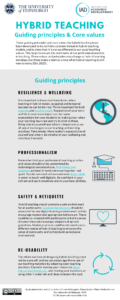These guiding principles and core values for hybrid teaching have been developed to try to find a common thread in hybrid teaching models, and to show that it is not so different to our usual teaching values. This helps to ensure the continuity of our professional practice in teaching.
This resource was developed from a loose literature review of the posts currently on the Hybrid Teaching Exchange, insights from the authors’ experience of digital education and conversations with academic colleagues as they prepared for hybrid teaching.
These values and principles may change as hybrid teaching develops, but these make a start at a time when hybrid teaching is still new to many (Oct 2020).
Hybrid teaching values Infographic
Guiding Principles
Resilience and wellbeing
It is important to have clear boundaries when teaching in hybrid modes, as spatial and temporal boundaries can be blurred. This is important for both students and teaching staff. Separation of your work and life is even more important. Set some expectations for your students by making clear when your working hours are and try to stick to these. Being kind to yourself and others is important as we all adjust to changes to our teaching and working practices. Take breaks. Have realistic expectations of yourself and others. Be mindful of your wellbeing and seek help if needed.
Guidance for students – https://www.ed.ac.uk/institute-academic-development/study-hub/learning-resources/hybrid-learning-and-teaching.
Guidance for staff – https://www.ed.ac.uk/staff/health-wellbeing.
Professionalism
Remember that your professional teaching practice and values should not be undermined by technological considerations. Technology and pedagogy go hand in hand and occur together, not apart. You do not need to have extensive digital skills in order to teach well digitally. Be confident in your skill set and use it creatively and to your best abilities.
Technology and pedagogy – https://www.teaching-matters-blog.ed.ac.uk/pedagogy-and-technology-from-a-postdigital-perspective/.
Digital skills – https://www.ed.ac.uk/information-services/help-consultancy/is-skills.
Safety and netiquette
Hybrid teaching should promote a safe environment for all participants. Good digital practices should be promoted for any digital learning environment to help encourage respect and appropriate behaviours. These could be co- created with participants to build a sense of ownership and encourage adoption of agreed guidelines. Similar practices could be mirrored across different modes of hybrid teaching to enhance the sense of community and to help build an inclusive environment.
Digital practices – http://www.docs.is.ed.ac.uk/skills/documents/3959/3959.pdf.
Re-usability
The effort and time of designing hybrid teaching need not be a one off, and we can encourage the re-use of our teaching materials by adopting open teaching practices. Consider making your resources Open Educational Resources, and sharing your materials, or using other’s materials and ideas to lessen the load.
Open Educational Resources – https://www.ed.ac.uk/information-services/learning-technology/open-educational-resources.
Core Values
Flexibility
Hybrid teaching should help students to move between modes of learning and make the transitions between them as fluid as possible. This will help enable learning and teaching to continue even when circumstances change for individuals. Modes can be synchronous (live) and asynchronous and can involve in person or digital environments. It does not assume that students only use one mode at any one time, and teaching can include elements of all.
Hybrid teaching – https://blogs.ed.ac.uk/learningexchange/2020/09/29/what-is-hybrid-teaching/.
Equity
Equivalency between modes of learning in hybrid teaching should be considered. However, this does not mean that students learning experiences should be the same. All students should feel respected and included and be able to achieve the learning objectives in all modes.
Students learning experiences – https://www.teaching-matters-blog.ed.ac.uk/equality-equity-and-social-justice-in-hybrid-education/.
Respect – https://www.ed.ac.uk/equality-diversity/respect.
Accessibility
The flexibility of hybrid teaching can allow greater accessibility. However, accessibility does not only apply to the learning materials, but must also consider access to technology and appropriate learning spaces. Hybrid teaching must be accessible on all levels and should be a core part of the design.
Accessible and inclusive learning – https://www.ed.ac.uk/institute-academic-development/learning-teaching/staff/inclusive/accessibility.
Accessibility – https://www.ed.ac.uk/information-services/help-consultancy/accessibility.
Community
Students should feel part of a single cohort, regardless of how they are able to attend or access the learning. It is important to encourage a sense of shared community and belonging both locally to the course and more widely at the School and University level.
Building community and belonging – https://blogs.ed.ac.uk/learningexchange/category/building-community-belonging/.
Fostering a Sense of Belonging at our University. A Guide for Schools – https://www.ed.ac.uk/files/atoms/files/belongingguide.pdf.
Engagement
Hybrid teaching should engage all students, and this might be done in different ways depending on the learning context. It’s important to try to recognise that digital teaching is different from in person teaching and both can be rich and engaging modes of learning.
Student engagement – https://www.ed.ac.uk/institute-academic-development/learning-teaching/staff/student-engagement.
Resources
- Edinburgh Hybrid Teaching Exchange – https://blogs.ed.ac.uk/learningexchange/.
- Teaching Matters Blog – https://www.teaching-matters-blog.ed.ac.uk/.
- Manifesto for teaching online – https://blogs.ed.ac.uk/manifestoteachingonline/.
Authors
Emily Woolen – Academic Developer, Institute for Academic Development
Celeste McLaughlin – Head of Academic Development for Digital Education, Institute for Academic Development
Fiona Quinlan-Pluck – Academic Developer, Institute for Academic Development
Joe Arton – Academic Developer, Institute for Academic Development



